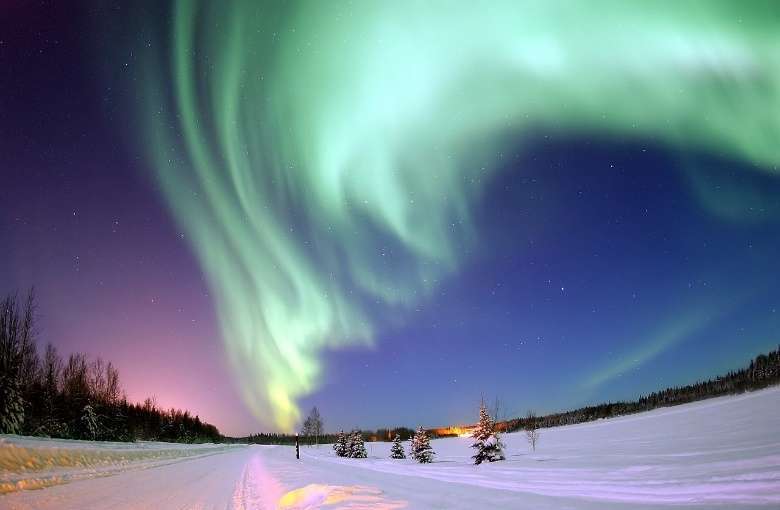If you live in or visit the Northern or Southern hemispheres, you might be able to have an amazing experience in their high latitudes. If you are lucky, you’ll be able to see some beautiful colorful light waves dancing in the sky. Usually, these are called aurora borealis. But there are a few other names too. In the Northern atmosphere, these are called northern lights, aurora Polaris or aurora borealis. In Southern Hemisphere, these are called southern lights or aurora australis. Inuit once believed that those auroras are dancing spirits of ancestors. I know, the main question you have is about white auroras. But before moving on to it, let’s consider some important facts about aurora borealis.
How do these Aurora Borealis happen?

Sometimes, the sun ejects charged particles (electrons and protons) from its upper atmosphere. This incident is called the solar wind and usually those solar winds have a speed up to 72 million Kilometers per hour! These solar winds reach the earth and hit the upper atmosphere of the earth called the ionosphere. The magnetic field of the earth deflects these electrons and protons towards the poles and then the energized particles in solar wind interact with the atoms in upper atmosphere of the earth.
When they collide with nitrogen and oxygen atoms in the ionosphere, it divides electrons from those atoms and they become ions. Then those ions start to emit radiation in different wavelengths creating different colors from red to greenish-blue. The Auroras are the results of those interactions. These auroras take place between 80-250 kilometers above the earth’s surface.
Besides earth, some other planets also display auroral activities. For example, Jupiter, Uranus, Saturn, and Neptune have atmospheres and magnetic fields. So they display large scale auroral activities.
What is the history of these Auroras?
Do you like to know where did the name “Aurora Borealis” came from? According to history in 1619, the Italian astronomer called Galileo Galilei was the one who introduced the name “Aurora Borealis”. He named it after the Roman Goddess “Aurora” and the Greek god “Boreas”. But the earliest record about these auroras is a cave painting found in France more than 30,000 years old.
Different civilizations around the world had different myths and beliefs about this aurora borealis. Vikings had believed that auroras were the light reflecting from the armor of great Valkyrie, who brings dead warriors to their afterlives. According to North American Inuit, those lights are spirits of their ancestors playing ball. Besides that many other astronomers in the past have reported about aurora borealis. For example, in 567 B.C., a royal astronomer has reported about the phenomenon. And also a Chinese report which dated back to 193 B.C. has reported about the aurora.
But the scientific theory behind this aurora borealis was presented in the 20th century by Kristian Birkeland, a Norwegian Scientist. According to him, electrons emitted from sunspots strike the magnetic field of the earth, and then it produces atmospheric lightning. But there are still many things to discover about this aurora borealis. The most recent example is finding how these solar particles gain their extraordinary speed. In June 2021 scientists have confirmed that particles get the acceleration through a phenomenon called Alfven waves.
How do these Auroras get their colors?
When considering the forms of Auroras, there are some different forms such as arcs, bands, patches, and luminous curtains. Among them, the arc form is the most stable one. When considering their colors, all forms of auroras get their colors in the same way. First of all, let’s talk about the sunlight. Do you know why sunlight appears in white? It is because the sun radiates all visible colors at once. So the combination is white. This is the same in auroras.
The wavelength of the emitted light causes the color of the aurora. As previously discussed, the upper atmosphere consists of different gases such as nitrogen and oxygen. When the energized particles hit those gases those atoms become ionized. Radiation of Ionized Nitrogen causes blue color and atomic Nitrogen cause to the deep red color. Atomic Oxygen causes other main colors of red and green in auroras.
Is it possible to see White Auroras?
I know this is the question you had from the beginning. If I give you a strict answer, my answer will be NO! Just consider the scientific mechanism behind auroras. As previously mentioned, the color depends on the wavelength of the emitted light. Aurora can have one or more colors. But to have white color, aurora needs to emit light in all visible wavelengths. Now you may have an idea why it is impossible to happen.
But there may be very bright colored auroras. When the light source color is very bright, it appears the color is washed out and it saturates your vision. This is the same reason why people see Jupiter in white from telescopes. Because of its brightness, we cannot have delicate color variation. Sometimes you may see white or transparent auroras from your naked eyes. But when you see such, use a camera and take some pictures. Cameras have much better sensors than your eyes and it will help to identify the true color in that aurora even we cannot see them through your eyes.
Everything is very open with a precise clarification of the challenges. It was really informative. Your website is useful. Thanks for sharing!